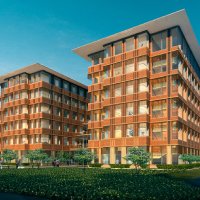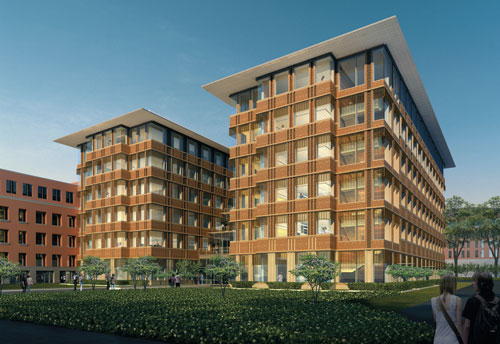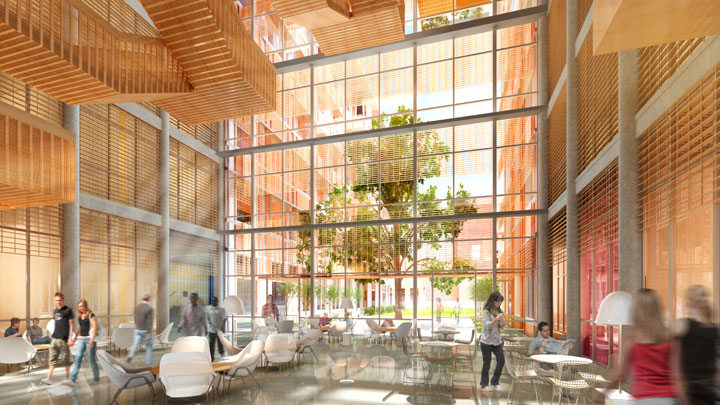Submitted by Staci R Norman on

 The Bill & Melinda Gates Computer Science Complex and Dell Computer Science Hall is under way with a projected completion date of winter 2012! The Gates Complex will be the first step in the department's plan to transform computing education and research in Texas.
The Bill & Melinda Gates Computer Science Complex and Dell Computer Science Hall is under way with a projected completion date of winter 2012! The Gates Complex will be the first step in the department's plan to transform computing education and research in Texas.
To facilitate advancement in computer science and its emerging interdisciplinary areas, the complex, consisting of two LEED certified buildings connected by an atrium, will include 17,500 assignable square feet of flexible and highly programmable research laboratory space, including labs in ten faculty research pods. All of this square footage is focused on encouraging research interaction and collaboration. Faculty and their grad students and research groups who share similar research interests inhabit each pod. In the center of each pod will be a 1,000 square foot lab; the pod will determine how that lab space is best used. In addition, the building will house Professor Peter Stone's Robotics Lab, Professor Dana Ballard's Virtual Reality Lab, and several uncommitted labs for incoming faculty.
One of the key advantages of the research lab space reflects that of the whole building—the department will no longer have to think small and worry about how to make cramped corners work and how to retrofit outdated space to meet current needs. The new building was designed to be flexible—to have enough infrastructure to allow researchers to think about the research that they want to do in the building rather than how to make the building support their research.
Having the entire department under one roof in a space that is conducive to interaction and collaboration will have a huge impact on the department’s research. Professor Lorenzo Alvisi, whose research focuses on distributed systems, says, regarding how the building will impact research in the department, “Let me count the ways! First, physical proximity with close colleagues and students. My work thrives through close and intense collaborations between faculty and students, and the new building is designed—from the layout of where student and faculty sit to the numerous and attractive meeting spaces—to facilitate such collaborations.” Lorenzo goes on to explain his vision on the new building as a conduit for collaboration. “Second, the new building gives serendipity a chance: some of my best ideas have begun from casual conversations with a colleague or a student met in a corridor or in the lounge: the architects of the new building have thought hard on how the building layout can enhance the chances for such fortuitous encounters: surrounded as we will be with whiteboards, casual conversations can seamlessly transition into exciting technical discussions.”

Faculty, staff, and students alike are looking forward to moving into the new building and being under one roof. "In the new building, I'm looking forward to seeing more colleagues more often, and of course, to the possibility of fruitful collaborations, as a result," said Assistant Professor Michael Walfish.

Students are, of course, the central focus of UTCS. Introducing our undergraduate students to and involving them in research is a part of the department’s innovative curriculum. "I believe the building will allow us to harness one of the resources of our department that space limitations made difficult to tap in to the past: the research creativity and enthusiasm of our undergraduate students. In the world of ideas, the classroom and the lab should never be far away in a research university like ours,” says Lorenzo. “In the new building, they will literally be just a few steps away: virtually every floor includes both classroom and research space.” The new Gates Complex will not only impact undergraduate research, but their entire academic experience here at UTCS. “Crucially, the building will also house lounges and studying spaces for undergraduates. While in the past many undergraduates have largely perceived the department as an administrative 'container' for their teachers, for the first time they will find themselves embedded in the exciting intellectual life that I am fortunate to be part of every day. I expect that the invisible wall that many undergraduate students still perceive between them and Research (with the scary capital R) will thankfully begin to crumble.”
Partnership is the lifeblood of the department and is anticipated to grow and thrive in the new building. “The new building will for the first time give us a chance to invite colleagues and collaborators from outside UT to visit us for extended periods of time. In a job that is about ideas and innovations, the periodic injection of fresh perspectives and new talent is critical,” explains Lorenzo. "I am especially looking forward to the opportunity to create close collaborations with industrial partners: a tremendously exciting development in this respect is the recent partnership between our lab and SunGard, one of the world’s leading software and technology services companies, to create a Cloud Computing Research Center. The new building will enable us to work side by side with SunGard engineers in developing the next generation of dependable and scalable storage services. I see this partnership as the first of many to come.“
The Bill & Melinda Gates Computer Science Complex and Dell Computer Science Hall is the vehicle for change for UTCS—from new collaborations and partnerships in research to creating an entirely new and enriched educational experience for our students. For more information, please contact us about the many opportunities available, including namings for major academic facilities, administrative facilities, student facilities, laboratories, and community and visitor spaces.







